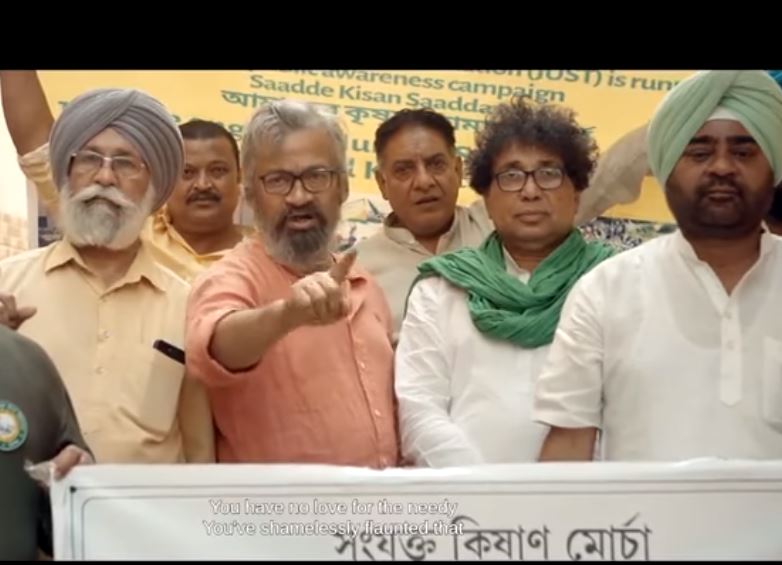The song of protest, the love of the nation. What else?
Bengal lives up to the expectation of being the initiator of a well-needed peoples’ protest, thanks to its creative fraternity

A still from the video
It was Bengal where the first battle for Independence – Indian Rebellion of 1857 -- took its shape, and the Bengal Renaissance in the late 19th and he 20th Century impacted the cultural and economic life of Bengal, thereby initiating an amazing progress in science and literature.
The City of Joy thus, has always been known for its peoples’ penchant for literature, poetry, music, and tea addas discussing painting, politics and protests.
Living up to the expectations of its glorious history amidst political upsurge and repeat hunger, the film, theatre and television fraternity of Bengal has become India’s first official assembly of protesters to rise and speak against the current government in no uncertain expressions.
In a clear voice of dissent, not only it challenges the government with tough words but also warns that it will not tolerate any nonsense that is being forcefully slipped through their throats.
Facts like these are collected and shown for greater impact in the film
In a very powerful video, comprising almost all well-known actors and actresses of the Bangla film, theatre and television industry, scorns the government for changing the real literature into fake narratives, creating differences among people in the name of religion but doing nothing of what a true religion says, not caring about death rates due to hunger, rape and atrocities, terrifying protestors and asking all those who speak against the government to go to Pakistan, it warns and states as a matter of fact “I will not go anywhere. I will stay in my motherland”, and “we will see you fall”!
This scene indicates how history books are changed to suit the government's fake narrative
The narrative of protest in powerful words weave a poignant a story in which a small girl is selling balloon on the road to make a living where the preparations for a demonstration through pamphlets, posters and gatherings, are on. An activist buys her balloon and joins the protestors of all age groups, from young students to famers, minorities, to those suffered because of the process of Citizenship Amendment Act, NRC and NPR, to children and women. They gather and flash strongly-worded posters and pamphlets. The disturbing fact-based stories on several issues from huger index to numerous rapes, historic fall of GDP, to rise of prices of petrol and gas, Rafael deal to killing humans in the name of religion, etc. fill the screen one by one.
The song challenges "I am not going anywhere. I will reside in my motherland"
The story ends with all gathering at one stage, echoing the very famous “Hum Dekhenge” nazm by poet Faiz Ahmad Faiz, sung by singer Iqbal Bnao in front of General Zia-ul-Haq inside the Parliament filled with 50,000 people in 1986, wearing a black sari, an attire banned in Haq’s Islamic Pakistan. The video closing with this protest anthem of the entire nation (Hum Dekhenge) in past few years, makes a fearless declaration.
The powerful video is replete with scenes like this
The concluding visuals thus symbolise the union of right-thinking people warning they won’t leave the country but witness the fall of this government, mincing no words. The baton is then passed on to the little girl who joins them dramatically, singing she would follow suit. Hence, it makes a clear statement that it will follow the Constitution of India penned by Dr .B. R Ambedkar, than any illogical and illegal chronicle being passed as law.
The film has subtexts in English
In this well-timed short film, the hard-hitting lyrics is penned by Anirban Bhattacharya, and the song is foot tapping yet poignant by Shubadeep Guha’s composition. Directed by Ridhdhi Sen and Rwitobroto Mukherjee, the video that has multiple well-known singers, daring the government openly.
A still from the film
It must hit the people with dead conscience who don’t rise on the occasion and speak up. Bengal's creative bhodro-lok have began a revolution already.
Those who performed in the film
One wonders when such an initiative will be taken by the Hindi film/television fraternity. Or will it have to make do with just a few Saeed Mirzas, Anurag Kashyaps, Swara Bhaskars, Nandita Dases, Zeeshan Ayubs, Anubhav Sinhas and Taapsee Pannus?
For breaking news and live news updates, like us on Facebook or follow us on Twitter and Instagram. Read more on Latest National News on The National Bulletin


